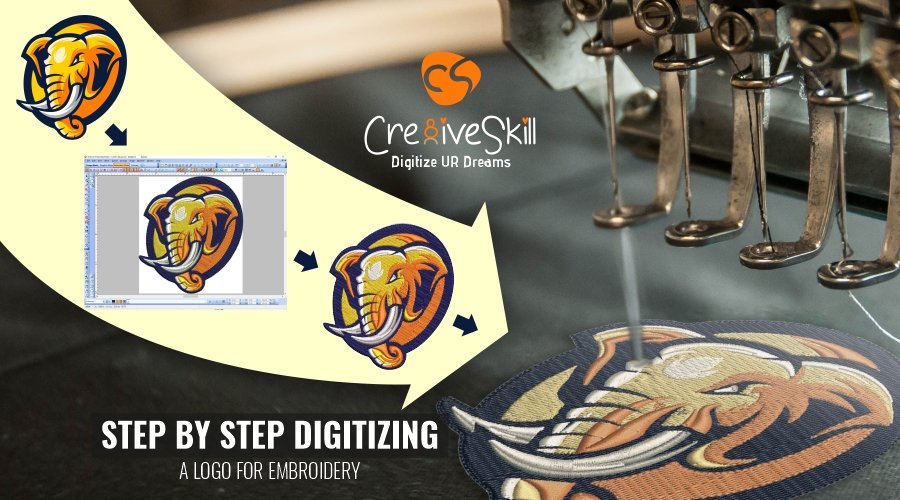Discover Different Sorts Of Needlework Digitizing Methods
Embroidery digitizing has actually advanced considerably over the years, using a myriad of strategies to bring layouts to life in the electronic realm. The realm extends to a lot more advanced methods like photorealistic needlework digitizing and the remarkable realm of 3D embroidery digitizing.
Standard Hand Embroidery Digitizing
Standard hand needlework digitizing entails the process of converting intricate hand-stitched layouts right into digital layouts for maker embroidery. This strategy requires skilled artisans to diligently analyze the handcrafted design and afterwards use specialized software application to recreate it in a digital format. Each stitch, shade, and information should be thoroughly translated to ensure that the significance of the initial hand embroidery is preserved in the electronic variation.
Among the essential challenges of traditional hand needlework digitizing is catching the complexities and subtleties of the handmade style. Digitizing for Embroidery. Artisans must have a deep understanding of various embroidery strategies, such as satin stitch, chain stitch, and French knots, to precisely replicate these strategies in the digital world. In addition, they need to have an eager eye for information to guarantee that the electronic style preserves the same degree of creativity and craftsmanship as the initial hand-stitched piece
Punching Method
To seamlessly change from conventional hand needlework digitizing to the punching strategy, artisans must currently focus on converting the complex digital layouts into instructions that needlework makers can interpret. The boxing method involves using specialized software to create digital data that consist of commands for the needlework maker to adhere to. This process calls for a deep understanding of not simply the layout itself however also the capabilities and limitations of the embroidery equipment.

Auto-Digitizing Software Program Programs
Embroidery digitizing has been transformed by the development of auto-digitizing software application programs, supplying craftsmens with innovative devices to transform digital designs into embroidery machine instructions efficiently. Auto-digitizing software application utilize algorithms to evaluate digital pictures or vector data and produce needlework layouts instantly. These programs permit quick and precise conversion of complex layouts right into stitch patterns, saving effort and time for embroiderers.
One of the vital benefits of auto-digitizing software is its easy to use user interface, making it obtainable to both novices and skilled digitizers. These programs often consist of attributes such as stitch editing tools, string shade matching, and the ability to preview the final embroidered design. Furthermore, auto-digitizing software program can deal with complex styles Going Here with numerous colors and intricate details, creating top quality embroidery documents appropriate for numerous clothing and fabric projects.
While auto-digitizing software application uses ease and efficiency, it is vital for individuals to recognize the restrictions of automated digitizing. Fine-tuning and hands-on adjustments may still be required to attain the wanted needlework quality, specifically when handling intricate or one-of-a-kind designs. By leveraging the abilities of auto-digitizing software application along with hand-operated digitizing techniques, craftsmens can boost their needlework digitizing process and create stunning embroidered items.
Photorealistic Embroidery Digitizing
Making use of advanced digital imaging strategies, achieving photorealistic results in needlework digitizing has become a desired skill among contemporary craftsmens. This technique includes transforming high-resolution photos right into elaborate stitch patterns that carefully resemble the original style, causing embroidery pieces that show realistic information and depth.
To achieve photorealistic needlework digitizing, craftsmens should have an eager eye for detail and a comprehensive understanding of just how different stitch kinds and thickness can influence the final end result. By thoroughly drawing up each color and color in the image, embroiderers can produce a digital documents that overviews the embroidery maker to reproduce Learn More the nuances of the original photo accurately.
Photorealistic needlework digitizing is especially prominent in creating personalized designs for garments, home design, and art items where capturing the essence of a picture or artwork is essential. This method enables craftsmens to transform memories, landscapes, portraits, and detailed artwork right into sensational stitched masterpieces that showcase a blend of standard craftsmanship and cutting-edge modern technology.
3D Needlework Digitizing
With the advancement of electronic imaging strategies in attaining original site photorealistic lead to embroidery digitizing, the exploration of 'D Embroidery Digitizing' uses a brand-new dimension to the complexities of design replication. 'D Needlework Digitizing' describes the three-dimensional digitizing method that includes deepness and appearance to embroidery styles, developing a much more practical and visually appealing last product. This strategy makes use of software program that mimics the effect of light and shadow on the needlework layout, improving its total aesthetic effect.
Among the key benefits of 'D Needlework Digitizing' is its ability to make designs look even more realistic and dynamic. By adding deepness to the needlework design, the last item shows up more realistic and exciting (Digitizing for Embroidery). In addition, this strategy enables even more creative freedom in layout execution, enabling embroiderers to experiment with various textures and results that were formerly challenging to achieve
Final Thought
